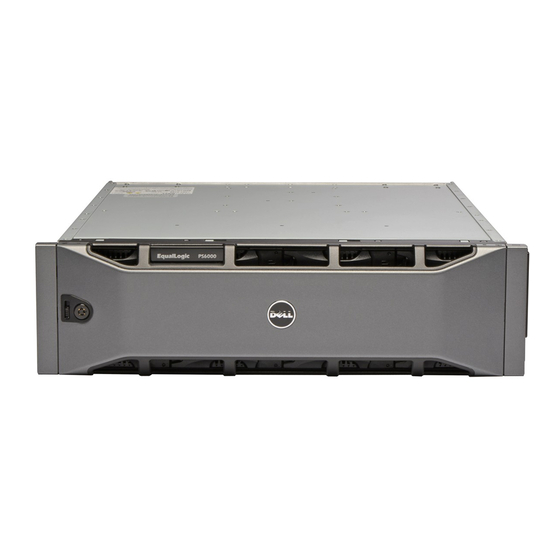Dell EqualLogic PS6100XV Manuel du matériel - Page 27
Parcourez en ligne ou téléchargez le pdf Manuel du matériel pour {nom_de_la_catégorie} Dell EqualLogic PS6100XV. Dell EqualLogic PS6100XV 50 pages. Equallogic ps series storage products
Également pour Dell EqualLogic PS6100XV : Vue d'ensemble (7 pages)

Preparing Your Systems For Clustering
CAUTION: Many repairs may only be done by a certified service technician. You should only perform
troubleshooting and simple repairs as authorized in your product documentation, or as directed by the online or
telephone service and support team. Damage due to servicing that is not authorized by Dell is not covered by your
warranty. Read and follow the safety instructions that came with the product.
Configuring A Cluster
The following instructions give you an overview on how to configure a cluster.
1.
Ensure that your site can handle the power requirements of the cluster. Contact your sales representative for
information about your region's power requirements.
2.
Install the systems, the shared storage array(s), and the interconnect switches (for example, in an equipment rack)
and ensure that all the components are turned on.
3.
Deploy the operating system (including any relevant service packs and hotfixes) and network adapter drivers on
each cluster node. Depending on the deployment method that is used, it may be necessary to provide a network
connection to successfully complete this step.
NOTE: To help in planning and deployment of your cluster, record the relevant cluster configuration information in
the Cluster Data Form and the iSCSI configuration information in the iSCSI Configuration Worksheet.
4.
Establish the physical network topology and the TCP/IP settings for network adapters on each cluster node to
provide access to the cluster public and private networks.
5.
Configure each cluster node as a member in the same Microsoft Active Directory Domain.
NOTE: You can configure the cluster nodes as Domain Controllers. For more information, see Selecting a Domain
Dell Failover Clusters with Microsoft Windows Server 2003 Installation and Troubleshooting Guide or
Model in the
Dell Failover Clusters with Microsoft Windows Server 2008 Installation and Troubleshooting Guide at
support.dell.com/manuals.
6.
Establish the physical storage topology and any required storage array(s) settings to provide connectivity between
the storage array(s) and the systems that you are configuring as cluster nodes. Configure the storage array(s) as
described in your storage array documentation.
7.
Use storage array management tools to create at least one volume and then assign the volume(s) to all cluster
nodes. The volume is used as a cluster Quorum disk for Microsoft Windows Server 2003 Failover Cluster or as a
Witness disk for Windows Server 2008 Failover Cluster.
8.
Select one of the systems and form a new Failover Cluster by configuring the cluster name, cluster management IP,
and quorum resource. For more information, see Preparing Your Systems For Clustering.
NOTE: For Failover Clusters configured with Windows Server 2008, run the Cluster Validation Wizard to ensure that
your system is ready to form the cluster.
9.
Join the remaining node(s) to the Failover Cluster. For more information, see Preparing Your Systems For Clustering.
10. Configure roles for cluster networks. Take any network interfaces that are used for iSCSI storage (or for other
purposes outside the cluster) out of the control of the cluster.
11. Test the failover capabilities of your new cluster.
NOTE: For Failover Clusters configured with Windows Server 2008, you can also use the Cluster Validation Wizard.
3
27
